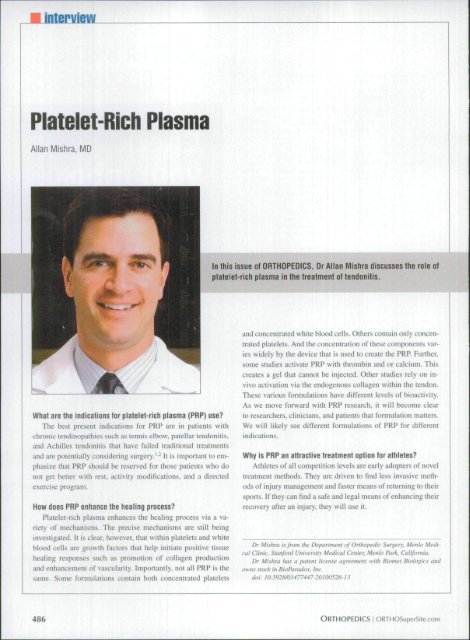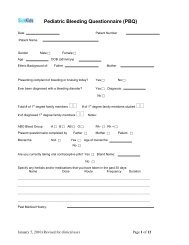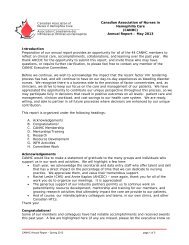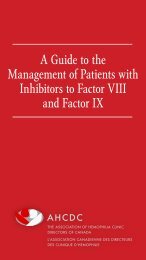Platelet-Rich Plasma
Platelet-Rich Plasma
Platelet-Rich Plasma
Create successful ePaper yourself
Turn your PDF publications into a flip-book with our unique Google optimized e-Paper software.
• interview<strong>Platelet</strong>-<strong>Rich</strong> <strong>Plasma</strong>Allan Mishra, MDIn this issue of ORTHOPEDICS, Dr Allan Mishra discusses the role ofplatelet-rich plasma in the treatment of tendonitis.What are the indications for platelet-rich plasma (PRP) use?The best present indications for PRP are in patients withchronic tendinopathies such as tennis elbow, patellar tendonitis,and Achilles tendonitis that have failed traditional treatmentsand are potentially considering surgei^.'- It is important to emphasizethat PRP should be reserved for those patients who donot get better with rest, activity modifications, and a directedexercise program.How does PRP enhance the healing process?<strong>Platelet</strong>-rich plasma enhances the healing process via a varietyof mechanisms. The precise mechanisms are still beinginvestigated. It is clear, however, that within platelets and whiteblood cells are growth factors that help initiate positive tissuehealing responses such as promotion of collagen productionand enhancement of vascularity. Importantly, not all PRP is thesame. Some formulations contain both concentrated plateletsand concentrated white blood cells. Others contain only concentratedplatelets. And the concentration of these components varieswidely by the device that is used to create the PRP. Further,some studies activate PRP with thrombin and or calcium. Thiscreates a gel that cannot be injected. Other studies rely on invivoactivation via the endogenous collagen within the tendon.These various formulations have different levels of bioactivity.As we move forward with PRP research, it will become clearto researchers, clinicians, and patients that formulation matters.We will likely see different formulations of PRP for differentindications.Why is PRP an attractive treatment option for athletes?Athletes of all competition levels are early adopters of noveltreatment methods. They are driven to find less invasive methodsof injury management and faster means of returning to theirsports. If they can find a safe and legal means of enhancing theirrecovery after an injury, they will use it.Dr Mishra is from the Department of Orthopedic Surgery, Menlo MedicalClinic, Stanford University Medical Center, Menlo Park, California.Dr Mishra has a patent license agreement with Biomet Biologies andowns stock in BioParadox. Inc.doi: 10.3928/01477447-20100526-13486 ORTHOPEDiCS I ORTHOSuperSite.com
interviewIs PRP a better solution than cortisone for treating tendoninjuries? It so, why?<strong>Platelet</strong>-rich plasma i.s clearly a better treatment for tendoninjuries than cortisone. A recent double-blind randomized trialfound significantly better outcomes in the treatment of tenniselbow in patients who received PRP when compared to cortisone.''''There is also a risk of dermal atrophy or even tendon rupturewhen using cortisone. For these rea.sons, I rarely, if ever, usecortisone in the treatment of a tendon problem in my practice.What role does ultrasound play in the use ot PRP?Ultrasound has already emerged as a excellent way to preciselyguide PRP injections. In the future, it will also be usedto document tendon lesion size and changes it over time. It maybe possible to use ultrasound as an objective measurement ofwhether and how PRP improves tendon structure and function.Has PRP heen shown to he more successtui in contributing tothe healing process of some injuries compared to others?Yes, tennis elbow has the best data supporting the use of PRPpresently. The use of PRP in mild to modetate Achilles tendinopathypatients that have not been treated with other means isnot supported in the literature. We need to continue to developbetter data to fully answer that question.What complications and risks are associated with the use ofPRP?<strong>Platelet</strong>-rich plasma is an autologous product produced andthen used itiimediately at the point of care. For these reasons, it isa very safe treatment. <strong>Platelet</strong>-rich plasma will have variable efficacybased on formulation and indication, but its safety profileis very high. I have noted transient pain, stiffness, and swellingbut no significant complications in over 9 years of using PRP asa treatment for tendinopathy.What does the future hold for PRP?We are just beginning to understand the potential value ofPRP. It may be useful for a variety of conditions, such as partialrotator cuff tears, partial tears of the ulnar collateral ligament ofthe elbow, and medial collateral ligament tears of the ktiee. Themost exciting area of future research with PRP is likely to be inFigure: Ultrasound of Achilles tendinopathy.conjunction with cartilage restoration. We need, however, to baseour PRP indications on high-level science, not anecdotal data inthe lay literature. This will take time and money to conduct theproper studies.Presently, many people think all PRP is the same. This is simplynot true. As we better understand how PRP works, we will beable to design more specific formulations. Specifically, we needa better understanding of how platelets and white blood cells interact.'<strong>Platelet</strong>-rich plasma also needs to be directly compared tosurgery for chronic tendinopathy. It may emerge as a better andless expensive option.HREFERENCES1 Mishra A, Paveiko T. Treatment of chronic elbow tendonosis with bufferedplatelet-rich pla.sma. Am J Sports Med. 2(K)6; 34( 11 ): 1774-1778.2. Mishra A, Woodall J Jr. Vieira A. Treatment of tendon and muscle usingplatelet rich plasma. Clin Sports Med, 2009; 28( 1 ): 113-125.3. Mishra A, Collado H. Fredericson M. <strong>Platelet</strong>-rich plasma comparedwith corticosteroid injeetion for chronic lateral elbow tendinosis. PM R.2009; l(4):366-370.4. Peerbooms JC. Sluimer J. Bruijn DJ. Gosens T Positive effect of an autologousplatelet concentrate in lateral epicondylitis in a double-blind randomizedcontrolled trial. <strong>Platelet</strong>-rich plasma versus corticosteroid injectionwith a 1 -year follow-up. Am J Sports Med, 2010; 38(2);255-262.5. Woodall J Jr. Mishra A, Tucci M. Cellular effects of platelet rich plasma:Interleukin-1 release from PRP treated macrophace cells. Biomed SeiInstrum. 2008; 44:489-494.(ULY 2010 I Volume 33 • Number 7 487
Copyright of Orthopedics is the property of SLACK Incorporated and its content may not be copied or emailedto multiple sites or posted to a listserv without the copyright holder's express written permission. However,users may print, download, or email articles for individual use.






